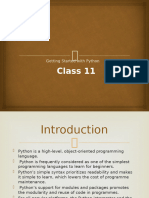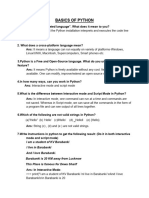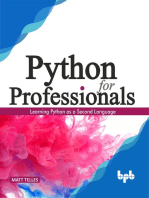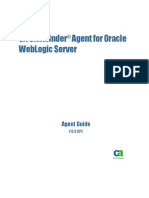Notes On Python
Uploaded by
sejalsingh387Notes On Python
Uploaded by
sejalsingh387Question answer on Python
1. What is the purpose of Python in AI?
Answer – Python is at the heart of every modern artificial intelligence system. It’s the programming
language of choice for data scientists and engineers creating the key infrastructure that drives today’s
most sophisticated AI systems. As a result, many companies are using Python to develop their next
generation of AI systems.
2. What are the benefits of Python Language?
Answer – The benefits of Python Language are
1. Simple to understand, read, and maintain
2. Clear syntax and a simple keyword structure
3. Python includes a large library of built-in functions that can be used to tackle a wide range of
problems.
4. Python features an interactive mode that enables interactive testing and debugging of code snippets.
5. Python runs on a wide range of operating systems and hardware platforms, with the same user
interface across all of them.
6. We can use the Python interpreter to add low-level models. These models allow programmers to
make their tools more efficient by customizing them.
7. Python includes interfaces to all major open source and commercial databases, as well as a more
structured and robust framework and support for big systems than shell scripting.
3. What are the different applications of Python?
Answer – The different application of Python are –
Web and Internet Development
2. Desktop GUI Application
3. Software Development
4. Database Access
5. Business Application
6. Games and 3D Graphics
4. What do you mean by Interactive Mode in Python shell?
Answer – Python IDLE Shell has a Python prompt where you can type single-line Python commands and
have them executed quickly.
5. What do you mean by Script Mode in Python Shell?
Answer – The Script Mode in Python allows you to add many lines of code. In script mode, we write a
Python programme to a file and then run it using the interpreter. Working in interactive mode is
advantageous for beginners and for testing small sections of code because it allows us to test them
immediately. When developing code with more than a few lines, however, we should always save it so
that we can change and reuse it later.
6. What is a python Statement?
Answer – A statement is a piece of code that a Python interpreter can execute. In other terms, a
statement is anything typed in Python. There are many different types of statements in the Python
programming language, including assignment statements, conditional statements, looping statements,
and so on.
7. What are Keywords?
Answer – In Python, keywords are reserved words that help the interpreter recognise the program’s
structure. Keywords are predefined terms in Python that have special meanings. The keyword isn’t
allowed to be used as a variable, function, or identifier. With the exception of True and False, all Python
keywords are written in lower case.
8. What are Identifiers?
Answer – A variable, function, class, module, or other object is given a name called an identifier. A string
of numerals and underscores make up the identifier. The identifier should start with a letter or an
Underscore and end with a numeric. The characters are A-Z or a-z, an UnderScore (_), and a numeric (0-
9). In identifiers, special characters (#, @, $, %,!) should be avoided.
9. What is Variable?
Answer – In a computer language, a variable is a memory area where a value is assign. A variable in
Python is created when a value is assigned to it. In Python, declaring a variable does not necessitate any
additional commands.
10. What are the different rules for declaring the Variable?
Answer – The rules for declaring variable are –
1. A number cannot be used as the first character in the variable name. Only a character or an
underscore can be used as the first character.
2. Python variables are case sensitive.
3. Only alpha-numeric characters and underscores are allowed.
4. There are no special characters permitted.
You might also like
- Expert System For Failure Analysis On Leading Edge Flap and Slat Position Indicating System Boeing 737ngNo ratings yetExpert System For Failure Analysis On Leading Edge Flap and Slat Position Indicating System Boeing 737ng11 pages
- question_bank_class_xi_cs_answer_to_be_uploaded-13No ratings yetquestion_bank_class_xi_cs_answer_to_be_uploaded-1345 pages
- Question Bank Class Xi Cs Answer To Be Uploaded-4No ratings yetQuestion Bank Class Xi Cs Answer To Be Uploaded-466 pages
- Class XI Q.Bank - Computer Science - All ChaptersNo ratings yetClass XI Q.Bank - Computer Science - All Chapters51 pages
- What Are The Key Features of Python?: Object Orientated ProgrammingNo ratings yetWhat Are The Key Features of Python?: Object Orientated Programming27 pages
- Python Interview Questions Answers Free PDFNo ratings yetPython Interview Questions Answers Free PDF16 pages
- Oral Exam question and answer Python ProgrammingNo ratings yetOral Exam question and answer Python Programming11 pages
- Python Programming For Beginners: Python Programming Language TutorialFrom EverandPython Programming For Beginners: Python Programming Language TutorialNo ratings yet
- python programming question bank unit wise by Rupesh ✓No ratings yetpython programming question bank unit wise by Rupesh ✓24 pages
- 9. Introduction to Python Class 9 Questions and AnswersNo ratings yet9. Introduction to Python Class 9 Questions and Answers4 pages
- I PUC CS Chapter 5 Getting Started With Python FinalNo ratings yetI PUC CS Chapter 5 Getting Started With Python Final30 pages
- Getting Started Python Chapter 5 NEW 14-09-2024No ratings yetGetting Started Python Chapter 5 NEW 14-09-20246 pages
- Class 9 Python Question Answers For Theory ExamNo ratings yetClass 9 Python Question Answers For Theory Exam4 pages
- Top 50+ Python Interview Questions and Answers (Latest 2024)No ratings yetTop 50+ Python Interview Questions and Answers (Latest 2024)14 pages
- Question Bank Class Xi Cs Answer To Be Uploaded-4 (2) RemovedNo ratings yetQuestion Bank Class Xi Cs Answer To Be Uploaded-4 (2) Removed5 pages
- Top 50+ Python Interview Questions and Answers (Latest 2024)No ratings yetTop 50+ Python Interview Questions and Answers (Latest 2024)14 pages
- Cisco ROSA Video Service Manager (VSM) Version 05.03No ratings yetCisco ROSA Video Service Manager (VSM) Version 05.0312 pages
- Csharp For Beginners The Tactical GuidebookNo ratings yetCsharp For Beginners The Tactical Guidebook979 pages
- Currency Converter in OOP SYSTEM PROJECTNo ratings yetCurrency Converter in OOP SYSTEM PROJECT9 pages
- Performance Optimization of Voice-Assisted FileManagement SystemsNo ratings yetPerformance Optimization of Voice-Assisted FileManagement Systems7 pages
- C401 - Earned Value & Financial Forecasting100% (1)C401 - Earned Value & Financial Forecasting73 pages
- Lecture_07 - Introduction to Operating SystemsNo ratings yetLecture_07 - Introduction to Operating Systems40 pages

























































































